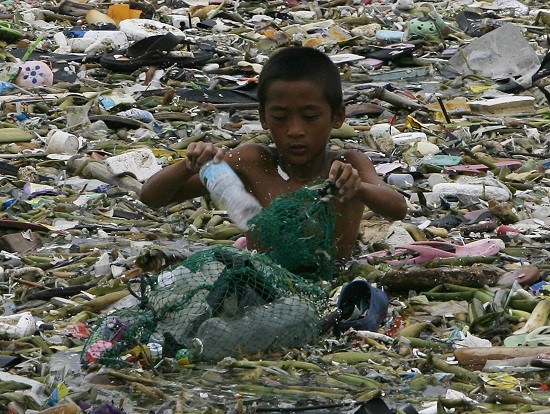Study: Over 250,000 Tons of Plastic Floating Around are Killing the Earth's Oceans
| Ana Verayo | | Dec 11, 2014 04:52 AM EST |
(Photo : Reuters) A boy collects plastic materials as he wades in murky waters surrounded by garbage.
Global plastic pollution in the oceans is almost overwhelming and scientists have just released the most accurate estimate of the massive amount of plastic floating on the planet's oceans.
A scientific team has determined there are around 5.35 trillion plastic pieces weighing about 250,000 tons floating in the oceans today.
Like Us on Facebook
The data was taken from 24 expeditions across sub-tropic regions beginning from 2007 to 2013. Using a computer generated model of the global ocean, a team led by Marcus Eriksen from the Five Gyres Institute will use this pivotal information along with wind data to reduce the massive amount of plastic in global oceans.
Environmentalists say plastic pollution exists in several concentrations around the world's oceans. This study provides a clearer estimate of how much trash is currently destroying marine ecosystems.
When it comes to plastic pollution found in oceans, larger pieces of trash are more common near the coastline while smaller pieces are being migrated to remote areas in the ocean.
As these smaller plastic pieces drift away, they are sucked in by gyres, which are areas that function like a whirlpool. The floating garbage accumulates in these whirlpools due to water and wind currents.
Scientists believe these gyres in the far reaches of the ocean act as garbage shredders that tear down the garbage into smaller pieces, disseminating plastic pieces all over the ocean.
Eriksen said their findings show garbage patches are found in five subtropical gyres. He says the effects of these floating garbage dumps doesn't end on the surface, and can ultimately destroy ocean ecosystems.
Plastic pollution originates from the northern hemisphere. The study revealed that garbage concentrations float off and accumulate in the south of the equator.
These findings suggest that the garbage migrates more quickly through gyres than previously thought and that microplastics the size of 0.19 inches across, sink faster in the north as opposed to the southern hemisphere.
The main cause for concern with this plastic pollution is that this massive amount of garbage isn't just broken down by the gyres but also by ultraviolet light from the sun. This process releases pollutants into the ocean that are consumed by marine wildlife.
This study was published in the online journal, PLOS One.
TagsStudy: Over 250, 000 Tons of Plastic Floating Around Killing the Earth's Oceans, plastic pollution, ocean pollution, gyres, how much garbage are floating in the ocean, oceans world global garbage plastic floating
©2015 Chinatopix All rights reserved. Do not reproduce without permission
EDITOR'S PICKS
-

Did the Trump administration just announce plans for a trade war with ‘hostile’ China and Russia?
-

US Senate passes Taiwan travel bill slammed by China
-

As Yan Sihong’s family grieves, here are other Chinese students who went missing abroad. Some have never been found
-

Beijing blasts Western critics who ‘smear China’ with the term sharp power
-

China Envoy Seeks to Defuse Tensions With U.S. as a Trade War Brews
-

Singapore's Deputy PM Provides Bitcoin Vote of Confidence Amid China's Blanket Bans
-

China warns investors over risks in overseas virtual currency trading
-

Chinese government most trustworthy: survey
-

Kashima Antlers On Course For Back-To-Back Titles
MOST POPULAR
LATEST NEWS
Zhou Yongkang: China's Former Security Chief Sentenced to Life in Prison

China's former Chief of the Ministry of Public Security, Zhou Yongkang, has been given a life sentence after he was found guilty of abusing his office, bribery and deliberately ... Full Article
TRENDING STORY

China Pork Prices Expected to Stabilize As The Supplies Recover

Elephone P9000 Smartphone is now on Sale on Amazon India

There's a Big Chance Cliffhangers Won't Still Be Resolved When Grey's Anatomy Season 13 Returns

Supreme Court Ruled on Samsung vs Apple Dispute for Patent Infringement

Microsoft Surface Pro 5 Rumors and Release Date: What is the Latest?










